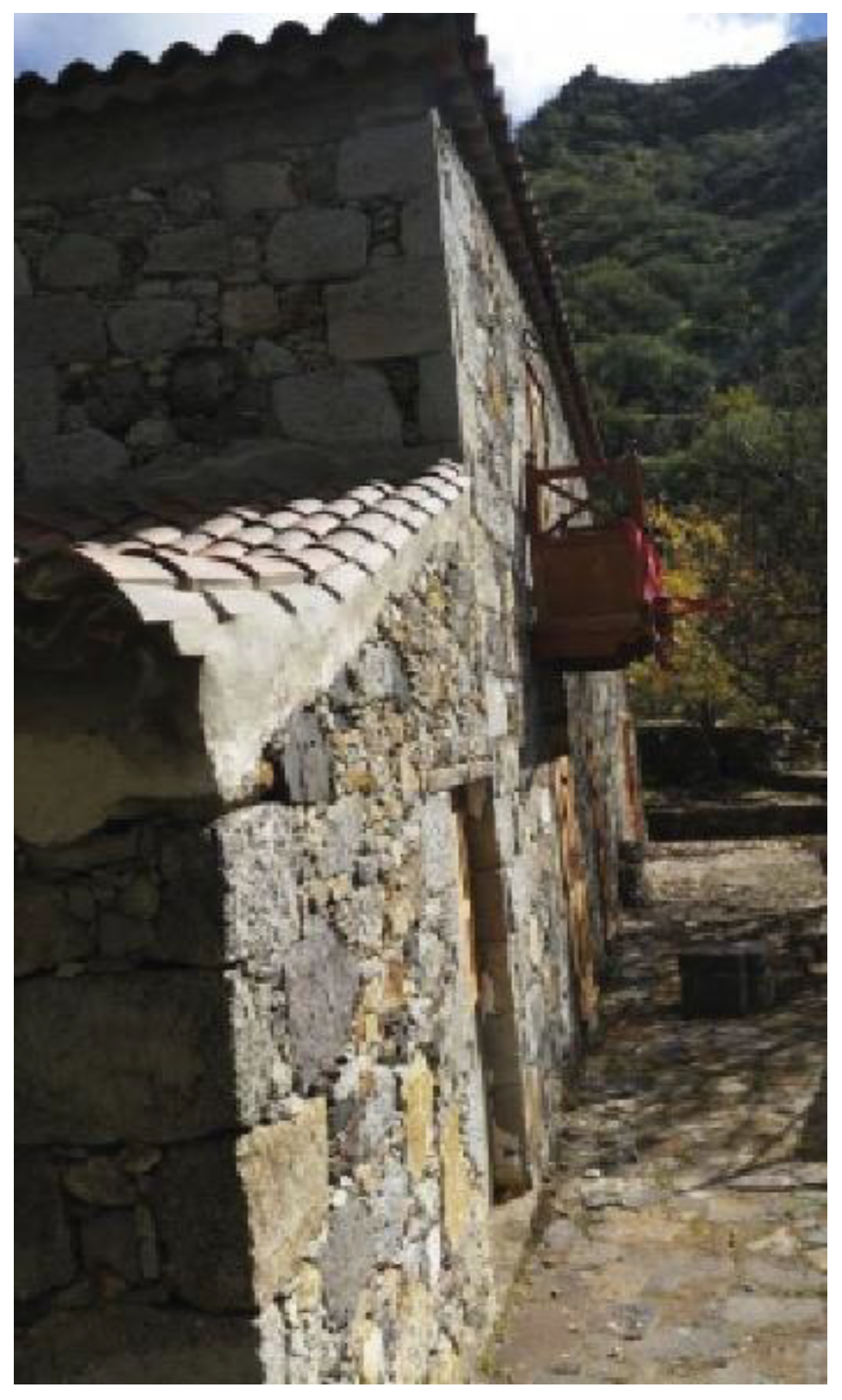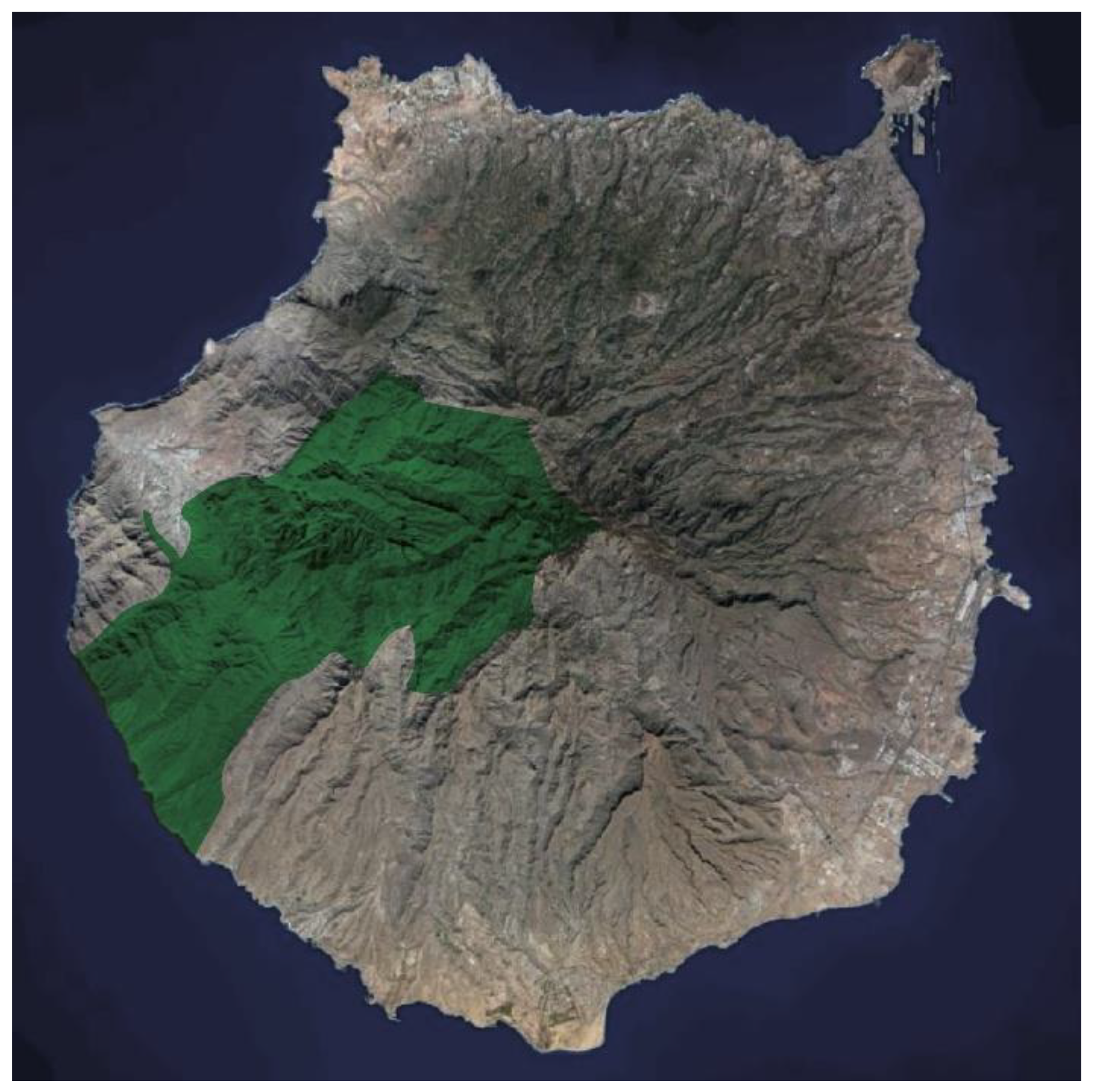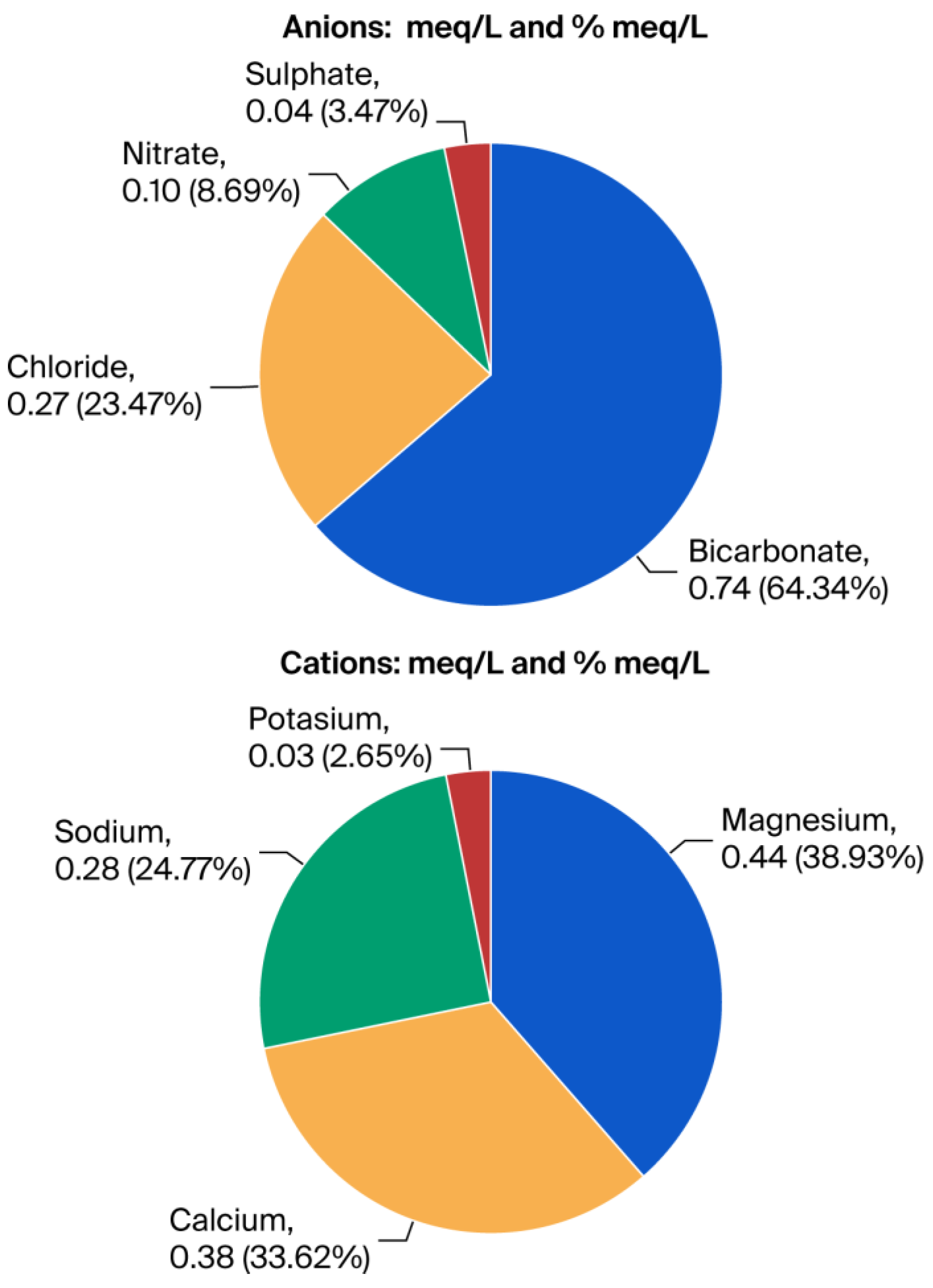Groundwater of Parque Rural del Nublo—UNESCO Biosphere Reserve and World Heritage Site “El Molinillo” Spring—Gran Canaria—Canary Islands—Spain
Abstract
1. Introduction
- Prove that Parque Rural del Nublo is significant at the regional, national and international level due to its unique ecological features and its biodiversity. This is why it was declared a UNESCO Biosphere Reserve on 29 June 2005. Later, on 7 July 2019, the 43rd session of the World Heritage Committee adopted the decision to inscribe the Cultural Landscape of Risco Caído and Montañas Sagradas de Gran Canaria on UNESCO’s World Heritage List.
- Describe some of the autochthonous medicinal herbs found in Parque Rural del Nublo, which benefit from the good quality and high silica content of the waters that emerge in the park.
- Value the work carried out by Centro de Plantas Medicinales de Tejeda (Centre of Medicinal Plants of Tejeda), first opened in 2007, which classifies and studies the phytochemicals of the plants in the park, many of which are used for therapeutic purposes in “complementary medicine” treatments.
- Describe the most known springs in the park, specifying their features and analysing the quality of the groundwaters of the spring “El Molinillo”, based on their organoleptic, physico-chemical, chemical and bacteriological parameters.
- Study the classification of the water as “drinking water” and “natural mineral water”, specifying its possible use as “mineral–medicinal water”, considering its potential pharmacological effects and therapeutic indications.
2. Materials and Methods
2.1. Study Area and Data
2.2. Water Samples Collection
2.3. Characteristics of Groundwater Water and Organoleptic Analysis
2.4. Physico-Chemical and Chemical Analysis
2.5. Diachronic Chemical Constancy
2.6. Bacteriological Analysis
3. Results
3.1. Characteristics of Groudwater and Organoleptic Analysis
3.2. Physico-Chemical and Chemical Analysis
3.3. Predominant Dissolved Substances (Chemical Analysis)
3.4. Bacteriological Analysis
4. Discussion
5. Conclusions
Funding
Data Availability Statement
Conflicts of Interest
References
- European Environment Agency. The Natura 2000 Protected Areas Network; Red Natura 2000; European Environment Agency: Copenhagen, Denmark, 2023. [Google Scholar]
- Nublo Rural Park. Declared a Biosphere Reserve on the 29 June 2005. International Coordinating Council of the MaB Programme. 2005. Available online: https://www.grancanaria.com/turismo/en/nature/world-biosphere-reserve/ (accessed on 15 June 2025).
- Risco Caído and the Sacred Mountains of Nublo Rural Park. UNESCO World Heritage Site. 2019. Available online: https://whc.unesco.org/en/list/1578/ (accessed on 15 June 2025).
- Nordgren, M.; Duvetorp, A. Psychosocial impact of climatotherapy in young patients with psoriasis: A 3-month cohort study. Front. Med. 2024, 11, 1458394. [Google Scholar] [CrossRef]
- Navarro, E. Assessment of the water quality of spring “La Mina”. Groundwater of Parque Rural del Nublo. Biosphere Reserve by UNESCO. Gran Canaria. Canary Islands. Int. J. Hydrol. 2024, 8, 128–133. [Google Scholar] [CrossRef]
- Ascanio-León, R. Gran Canaria and Its Underground Waters; Curbelo, M., Ed.; ULPGC: Tenerife, Spain, 1926. [Google Scholar]
- Official Gazette of the Canary Islands. (BOC) 2014. Tuesday, 4 February 2014—411. Directorate-General for Industry and Energy. Announcement of 28 January 2014, Making Public the Order of 13 January 2014, Declaring the Status of “Natural Mineral Water” for the Springs Called “El Molinillo,” Located in the Municipality of Tejeda, Gran Canaria. File No. 35B00001. 2014. Available online: https://sede.gobiernodecanarias.org/boc/boc-a-2014-023-410.pdf (accessed on 15 June 2025).
- Díaz, J.M. Gran Canaria Water Mills, 2nd ed.; Caja Insular de Ahorros de Gran Canaria: Las Palmas de Gran Canaria, Spain, 1989. [Google Scholar]
- Santamarta, J.C. Hydrology and Water Resources on Islands and Volcanic Terrains; Colegio de Ingenieros de Montes: Madrid, Spain, 2013. [Google Scholar]
- Bramwell, D.; Bramwell, Z. Wild Flowers of the Canary Islands; Editorial Rueda Alcorcón: Madrid, Spain, 2001. [Google Scholar]
- Tessema, F.; Asfaw, T.; Tadesse, M.; Bachheti, R.K.; Gonfa, Y.H.; Addisie, D.S.; Aregahegn, T.G.; Tadesse, T.G.; Aboneh, M. Exploring antimicrobial properties and oral health benefits of salix subserrata willd: Unveiling the potential beyond its use as traditional chewing stick. BMC Complement. Med. Ther. 2025, 25, 117. [Google Scholar] [CrossRef]
- Dévora, S.; Abdala, S.; Martín, D. The bioguided fractionation and pharmacological activity of an endemic Salix canariensis species. Acta Pharm. 2017, 67, 265–273. [Google Scholar] [CrossRef]
- Sharma, S.; Sahu, D.; Das, H.R.; Sharma, D. Amelioration of collagen-induced arthritis by Salix nigra bark extract via suppression of pro-inflammatory cytokines and oxidative stress. Food Chem Toxicol. 2011, 49, 3395–3406. [Google Scholar] [CrossRef]
- Martín, A.; Hernández, E.; Nogales, M.; Quilis, V.; Trujillo, O.; Delgado, G. The Red Book of Terrestrial Vertebrates of the Canary Islandsd; Caja General de Ahorros de Canarias: Santa Cruz de Tenerife, Spain, 1990. [Google Scholar]
- García, E. Birds of the Canary Islands, 1st ed.; Christopher Helm: London, UK, 2018. [Google Scholar]
- Pérez, P. Gran Canaria Biosphere Reserve. MaB Programme. UNESCO. 29 June 2005. Available online: https://www.atlasruraldegrancanaria.com/la-reserva-de-la-biosfera-de-gran-canaria/ (accessed on 15 June 2025).
- Maraver, F.; Vázquez, I.; Armijo, F. Vademecum III of Spanish Mineral-Medicinal Waters; Editorial Complutense; Instituto de Salud Carlos III: Madrid, Spain, 2020. [Google Scholar]
- Official State Gazette. (BOE No. 16, of 19/01/2011). Royal Decree 1798/2010, of 30 December, Regulating the Exploitation and Marketing of Natural Mineral Waters and Packaged Spring Waters for Human Consumption in Spain. 2011. Available online: https://www.boe.es/eli/es/rd/2010/12/30/1798/con (accessed on 15 June 2025).
- UNE-EN ISO 20236-2022; Calidad del Agua. Asociación Española de Normalización (UNE): Madrid, Spain, 2022.
- UNE-EN ISO 10304-1 2009; Calidad del Agua. Asociación Española de Normalización y Certificación. (AENOR): Madrid, Spain, 2009.
- UNE-ISO 14911-2000; Calidad del Agua. Asociación Española de Normalización y Certificación. (AENOR): Madrid, Spain, 2000.
- World Health Organization. Guidelines for Drinking-Water Quality, 4th ed.; World Health Organization: Geneva, Switzerland, 2011. [Google Scholar]
- Marrero, A. The Dasygnaphala Sideritis Complex of the Island of Gran Canaria (Canary Islands). A single species or a Complex of old taxa, some on the verge of extinction? Bot. Macaronésica 2023, 32, 175–230. [Google Scholar]
- Custodio, E.; Cabrera, M.C.; Poncela, R.; Puga, L.O.; Skupien, E.; Villar, A. Groundwater intensive exploitation and mining in Gran Canaria and Tenerife, Canary Islands, Spain: Hydrogeological, environmental, economic and social aspects. Sci. Total Environ. 2016, 557–558, 425–447. [Google Scholar] [CrossRef]
- Dobrzyński, D.; Cruz-Fuentes, T.; Kostka, A.; Cabrera, M.; Hernández-Quesada, P. The origin of high silicon content in potentially medicinal groundwater of Gran Canaria (Canary Islands, Spain). Modelling of chemical water-rock interactions. Balneo Res. J. 2012, 3, 108–124. [Google Scholar] [CrossRef]
- Rice, E.W.; Baird, R.B.; Eaton, A.D. Standard Methods for the Examination of Water & Wastewater, 23rd ed.; American Public Health Association: Washington, DC, USA; American Water Works Association: Denver, CO, USA; Water Environment Federation: Alexandria, VA, USA, 2017. [Google Scholar]
- Navarro, E.; Velázquez, R.; Alonso, J. Gastrointestinal stimulant activity of “Fuenteror” mineral waters vs. others mineral waters of Canary Islands. Bol. Soc. Esp. Hidrol. Méd. 2014, 29, 153–154. [Google Scholar] [CrossRef]
- Armijo, M.; Baicacoa, J. Balneary and Climatic Treatments. In Thalassotherapy and Heliotherapy; Editorial Complutense: Madrid, Spain, 1994. [Google Scholar]
- San José, C. Medical Hydrology and Complementary Therapies, 2nd ed.; Universidad de Sevilla: Sevilla, Spain, 2012. [Google Scholar]
- Rudzka-Kantoch, Z.; Weker, H. Water in children’s diet. Med. Wieku Rozwoj. 2000, 4 (Suppl. S1), 109–115. [Google Scholar] [PubMed]
- Brubaker, P.; Greger, J.; Freeland, J. Drinking Water Advisory: Consumer Acceptability Advice and Health Effects Analysis on Sodium; U.S. Environmental Protection Agency: Washington, DC, USA, 2003.
- Pennington, J.A. Silicon in foods and diets. Food Addit. Contam. 1991, 8, 97–118. [Google Scholar] [CrossRef]
- Jugdaohsingh, R.; Tucker, K.L.; Qiao, N.; Cupples, L.A.; Kiel, D.P.; Powell, J.J. Dietary silicon intake is positively associated with bone mineral density in men and premenopausal women of the Framingham Offspring cohort. J. Bone Min. Res. 2004, 19, 297–307. [Google Scholar] [CrossRef]
- Prescha, A.; Zabłocka-Słowińska, K.; Grajeta, H. Dietary Silicon and its impact on plasma silicon levels in the Polish population. Nutrients 2019, 11, 980–984. [Google Scholar] [CrossRef]
- Martin, K.R. The chemistry of silica and its potencial health benefits. J. Nutr. Health Aging 2007, 11, 94–98. [Google Scholar] [PubMed]
- Price Charles, T.; Koval Kenneth, J.; Langford Joshua, R. Silicon: A Review of Its Potential Role in the Prevention and Treatment of Postmenopausal Osteoporosis. Int. J. Endocrinol. 2013, 2013, 316783. [Google Scholar] [CrossRef]
- Lewinson, J.; Mayr, W.; Wagner, H. Characterization and toxicological behavior of synthetic amorphous hydrophobic silica. Regul. Toxicol. Pharmacol. 1994, 20, 37–57. [Google Scholar] [CrossRef]
- Martin, K.R. Silicon: The health benefits of a metalloid. Met. Ions Life Sci. 2013, 13, 451–473. [Google Scholar] [PubMed]
- Sripanyakorn, S.; Jugdaohsingh, R.; Dissayabutr, W.; Anderson, S.; Thompson, J. The comparative absorption of silicon from different foods and food supplements. Br. J. Nutr. 2009, 102, 825–834. [Google Scholar] [CrossRef]
- Gillette, S.; Andrieu, S.; Vellas, B. The possible influence of silica present in drinking water on Alzheimer’s disease and associated disorders. J. Nutr. Health Aging 2007, 11, 119–124. [Google Scholar] [PubMed]
- Radovanovic, Z.; Djindjic, B.; Dzopalic, T.; Veljkovic, A.; Dunjic, M.; Krstic, D.; Djindjic, N.; Nedeljkovic, B. Effect of silicon-rich water intake on the systemic and peritoneal inflammation of rats with chronic low levels of aluminum ingestion. J. Trace Elem. Med. Biol. 2018, 46, 96–102. [Google Scholar] [CrossRef]
- Savita, B.; Dhriti, K. Fascinating regulatory mechanism of silicon for alleviating drought stress in plants. Plant Physiol. Biochem. 2021, 166, 1044–1053. [Google Scholar] [CrossRef]
- Xu, R.; Huang, J.; Guo, H.; Wang, C.; Zhan, H. Functions of silicon and phytolith in higher plants. Plant Signal. Behav. 2023, 31, 2198848. [Google Scholar] [CrossRef]






| Origen | Denomination | Municipality | Classification | Declaration Year | Geographical Coordinates | Hydrochemical Facies |
|---|---|---|---|---|---|---|
| G | El Molinillo | Tejeda | NMW | 2014 | X = 441.983 | MgCO3H |
| Y= 3095.122 | ||||||
| S | La Mina | Tejeda | NMW | 2014 | X = 441.891 | MgCO3H |
| Y= 3096.511 | ||||||
| G | Túnel de Tejeda | Tejeda | NMW | 1999 | X = 448.147 | CaCO3H |
| Y= 3104.745 | ||||||
| S | Taguigui | Tejeda | NMW | 1996 | X = 448.160 | NaCO3H |
| Y= 3104.811 | ||||||
| S | La Fuente Fría | Tejeda | NMW | 2002 | X = 448.697 | NaCO3H |
| Y= 3104.819 | ||||||
| S | La Florida | S. Bartolomé de Tirajana | NMW | 2000 | X = 460.622 | NaCl |
| Y= 3085.701 | ||||||
| S | Manantial de Sorrueda | S. Bartolomé de Tirajana | NMW | 2000 | X = 447.323 | Na CO3H |
| Y= 3084.609 | ||||||
| S | La Rosiana | S. Bartolomé de Tirajana | MMW | 1995 | X = 445.606 | NaCl |
| Y= 3088.297 | ||||||
| W | El Zumacal II | Valleseco | NMW | 1998 | X = 444.201 | NaCO3H |
| Y= 3103.539 | ||||||
| W | San Antón | Valleseco | NMW | 1997 | X = 444.495 | NaCO3H |
| Y= 3105.552 | ||||||
| W | La Gambuesilla | Valleseco | NMW | 2002 | X = 420.084 | NaCl |
| Y= 3096.687 | ||||||
| G | La Umbridillla | Mogán | NMW | 2022 | X = 427.055 | NaCO3H |
| Y= 3081.837 | ||||||
| G | Huerta del Molino | San Mateo | NMW | 1995 | X = 447.885 | NaCO3H |
| Y= 3098.259 |
| Parameters | Maximum | Minimum | Mean | Standard Deviation | Parametric Value for Mineral Natural Water |
|---|---|---|---|---|---|
| pH | 7.70 | 7.40 | 7.52 | 0.06 | 5.5–9.5 Alkaline water |
| Conductivity at 25 °C (µS.cm−1) | 116 | 110 | 112 | 2.06 | 100–200 Low conductivity water |
| Dry residue at 180 °C (mg/L) | 114 | 101 | 108 | 4.88 | 100–250 weak mineralisation water |
| Total hardness (mg/L CO3Ca) | 43.8 | 38.6 | 42.3 | 1.50 | 0–50 Very soft water |
| Total organic Carbon (mg C/L) | <0.1 | <0.1 | <0.1 | - | >5 mg/L Organic Matter Indicator |
| Silica (mg SiO2/L) | 42.0 | 38.6 | 41.8 | 1.29 | >30 mg/L Silica water |
| Bicarbonate (mg HCO3/L) | 46.4 | 42.9 | 45.2 | 1.27 | 250 mg/L |
| Carbonate (mg CO3/L) | <1.2 | <1.2 | <1.2 | - | - |
| Sulphate (mg SO4/L) | 2.3 | 2.0 | 2.1 | 0.29 | <250 mg/L |
| Chloride (mg Cl/L) | 10.2 | 9.2 | 9.6 | 0.27 | <250 mg/L |
| Nitrate (mg NO3/L) | 6.9 | 6.3 | 6.8 | 0.28 | <50 mg/L |
| Fluoride (mg F/L) | <0.1 | <0.1 | <0.1 | - | <1.5 mg/L |
| Nitrite (mg NO2/L) | <0.01 | <0.01 | <0.01 | - | <3 mg/L |
| Ʃ anions (meq/L) | 1.19 | 1.10 | 1.15 | ||
| Calcium (mg Ca/L) | 8.6 | 7.4 | 7.6 | 0.36 | <150 mg/L |
| Magnesium (mg Mg/L) | 6.0 | 5.0 | 5.4 | 0.31 | <50 mg/L |
| Sodium (mg Na/L) | 7.1 | 6.5 | 6.6 | 0.31 | <200 mg/L |
| Potasium (mg K/L) | 1.7 | 1.4 | 1.5 | 0.30 | |
| Amonium (mg NH4/L) | <0.10 | <0.10 | <0.10 | - | <0.20 mg/L |
| Ʃ cations (meq/L) | 1.16 | 1.12 | 1.13 |
| Parameter | Result | Parametric Value | Units (cfu/mL) |
|---|---|---|---|
| Colony count 22 °C/72 h | <3 | ----- | (cfu/mL) |
| Colony count 37 °C/72 h | <3 | ----- | (cfu/mL) |
| Coliform bacteria | 0 | 0 | (cfu/250 mL) |
| Eschreichia coli | 0 | 0 | (cfu/250 mL) |
| Salmonella spp. | absence | absence | (in 250 mL) |
| Faecal Streptococci | 0 | 0 | (cfu/250 mL) |
| Sporulated sulphite reducing anaerobes | 0 | 0 | (cfu/50 mL) |
| Pseudomonas aeruginosa | 0 | 0 | (cfu/250 mL) |
Disclaimer/Publisher’s Note: The statements, opinions and data contained in all publications are solely those of the individual author(s) and contributor(s) and not of MDPI and/or the editor(s). MDPI and/or the editor(s) disclaim responsibility for any injury to people or property resulting from any ideas, methods, instructions or products referred to in the content. |
© 2025 by the author. Licensee MDPI, Basel, Switzerland. This article is an open access article distributed under the terms and conditions of the Creative Commons Attribution (CC BY) license (https://creativecommons.org/licenses/by/4.0/).
Share and Cite
Navarro, E. Groundwater of Parque Rural del Nublo—UNESCO Biosphere Reserve and World Heritage Site “El Molinillo” Spring—Gran Canaria—Canary Islands—Spain. Water 2025, 17, 3373. https://doi.org/10.3390/w17233373
Navarro E. Groundwater of Parque Rural del Nublo—UNESCO Biosphere Reserve and World Heritage Site “El Molinillo” Spring—Gran Canaria—Canary Islands—Spain. Water. 2025; 17(23):3373. https://doi.org/10.3390/w17233373
Chicago/Turabian StyleNavarro, Eduardo. 2025. "Groundwater of Parque Rural del Nublo—UNESCO Biosphere Reserve and World Heritage Site “El Molinillo” Spring—Gran Canaria—Canary Islands—Spain" Water 17, no. 23: 3373. https://doi.org/10.3390/w17233373
APA StyleNavarro, E. (2025). Groundwater of Parque Rural del Nublo—UNESCO Biosphere Reserve and World Heritage Site “El Molinillo” Spring—Gran Canaria—Canary Islands—Spain. Water, 17(23), 3373. https://doi.org/10.3390/w17233373






